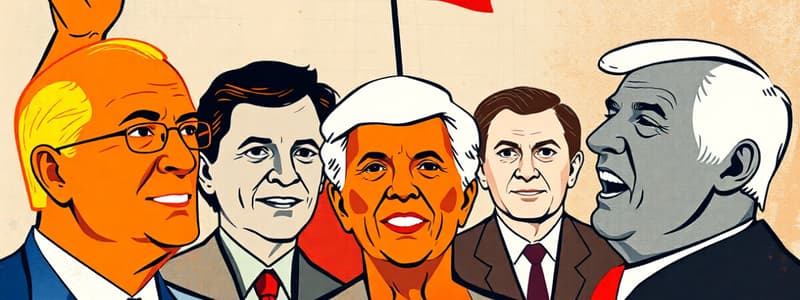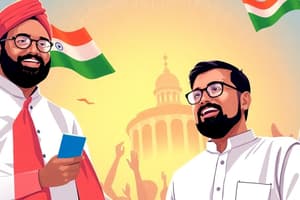Podcast
Questions and Answers
What is one potential consequence of declining party membership?
What is one potential consequence of declining party membership?
- More competitive election processes
- Increased political party funding from private sources
- Greater public trust in political parties
- Reduced relevance of party organizational capacity (correct)
Which of the following is NOT a form of regulation that political parties are subject to?
Which of the following is NOT a form of regulation that political parties are subject to?
- Limitations on party membership registration (correct)
- Control over campaign spending
- Public subventions for party activities
- Regulations on fundraising contributions
What challenge do political parties face in terms of public perception?
What challenge do political parties face in terms of public perception?
- Strong alignment with all interest organizations
- Increased trust compared to previous years
- Decreased trust and identification from the public (correct)
- Higher membership rates than ever before
Which alternative to traditional political parties is suggested in the context of contemporary political challenges?
Which alternative to traditional political parties is suggested in the context of contemporary political challenges?
What solution is suggested for parties to reconnect with the public?
What solution is suggested for parties to reconnect with the public?
What is a defining characteristic of mass parties?
What is a defining characteristic of mass parties?
Which type of party emerged from the transformation of mass parties during the 20th century?
Which type of party emerged from the transformation of mass parties during the 20th century?
What is a feature of cartel parties in the last quarter of the 20th century?
What is a feature of cartel parties in the last quarter of the 20th century?
What distinguishes anti-cartel parties from traditional parties?
What distinguishes anti-cartel parties from traditional parties?
What is the primary characteristic of light parties?
What is the primary characteristic of light parties?
Which feature is characteristic of parties in the United States?
Which feature is characteristic of parties in the United States?
Regarding party membership, which form is NOT one of the types mentioned?
Regarding party membership, which form is NOT one of the types mentioned?
What measurement does NOT typically apply to assessing party membership?
What measurement does NOT typically apply to assessing party membership?
What distinguishes parties of intra-parliamentary origin from those of extra-parliamentary origin?
What distinguishes parties of intra-parliamentary origin from those of extra-parliamentary origin?
Which function of political parties best describes their role in linking citizens to the government?
Which function of political parties best describes their role in linking citizens to the government?
Which element is NOT typically included in definitions of political parties?
Which element is NOT typically included in definitions of political parties?
What is a primary characteristic of cadre/elite parties?
What is a primary characteristic of cadre/elite parties?
Which function of parties involves the formulation of policy propositions?
Which function of parties involves the formulation of policy propositions?
What is one way political parties help integrate new citizens into political life?
What is one way political parties help integrate new citizens into political life?
Which group primarily influenced the establishment of intra-parliamentary parties historically?
Which group primarily influenced the establishment of intra-parliamentary parties historically?
What is the significance of extra-parliamentary parties in the context of political participation?
What is the significance of extra-parliamentary parties in the context of political participation?
Flashcards
Political Party
Political Party
A group of individuals sharing similar political beliefs, aiming to influence government policy and gain power through elections, and acting as a link between citizens and the government.
Intra-Parliamentary Party Origins
Intra-Parliamentary Party Origins
Political parties originated from within existing parliaments, focusing on gaining control of the executive branch and driving the rise of parliamentary governments.
Extra-Parliamentary Party Origins
Extra-Parliamentary Party Origins
Political parties emerged outside of parliament, often to advocate for groups excluded from political participation, such as women or the working class.
Coordination Role of Parties
Coordination Role of Parties
Signup and view all the flashcards
Parties in Election Contests
Parties in Election Contests
Signup and view all the flashcards
Recruitment and Selection by Parties
Recruitment and Selection by Parties
Signup and view all the flashcards
Representation by Parties
Representation by Parties
Signup and view all the flashcards
Cadre/Elite Parties
Cadre/Elite Parties
Signup and view all the flashcards
Mass Parties
Mass Parties
Signup and view all the flashcards
Catch-all Parties
Catch-all Parties
Signup and view all the flashcards
Cartel Parties
Cartel Parties
Signup and view all the flashcards
Anti-cartel Parties
Anti-cartel Parties
Signup and view all the flashcards
Light Parties
Light Parties
Signup and view all the flashcards
Parties in the US
Parties in the US
Signup and view all the flashcards
Party Membership
Party Membership
Signup and view all the flashcards
Individual Membership
Individual Membership
Signup and view all the flashcards
Regulation of Political Parties
Regulation of Political Parties
Signup and view all the flashcards
Financial Regulation of Parties
Financial Regulation of Parties
Signup and view all the flashcards
Declining Party Membership
Declining Party Membership
Signup and view all the flashcards
Rise of Competing Interest Organizations
Rise of Competing Interest Organizations
Signup and view all the flashcards
Alternatives to Political Parties
Alternatives to Political Parties
Signup and view all the flashcards
Government by Technocrats
Government by Technocrats
Signup and view all the flashcards
Study Notes
Political Parties
- Definitions vary, but most combine objective, methods (electoral and governing), role in competition, and role in democracy.
- Earlier parties were often intra-parliamentary, succeeding in controlling the executive and rising parliamentary government.
- Extra-parliamentary parties emerged to organize previously excluded groups (before universal suffrage). More recently, they include entrepreneurs.
- Intra- vs. extra-parliamentary parties differ in timing (extra came later), organization, and social basis (e.g., upper classes for intra, middle/lower classes for extra)
Function of Parties
- Coordination: bridge between government/parliament and sub-national levels, and between government and society. Acts as a link between citizens and government.
- Contesting Elections: Provide candidates, conduct campaigns, and formulate policy proposals.
- Recruitment/Selection: Recruit and select candidates to fill positions effectively. Integrate new citizens into political life.
- Representation: Represent the electorate, social groups, and ideologies.
Models of Party Organization
- Cadre/Elite Parties: Earliest modern parties (restricted suffrage), central office less important, focusing on mobilizing existing constituencies.
- Mass Parties: Second half of the 19th century (extra-parliamentary origins). Represent a group/class and build on existing organizations (e.g., unions). Extensive organization, dominated by elites.
- Catch-All Parties: Evolved from mass parties, increasing importance to reach across group boundaries, with weaker ideological focus and lessening connection to interest organizations. Attempt to represent diverse social classes and ideologies.
- Cartel Parties: Under pressure due to public debt (20th century). Featured agencies of the state, professionalization, and protection from risks.
Anti-Cartel Parties
- Frustration with 'mainstream' parties.
- Organized around ideas rather than social groups (e.g., "left libertarian", "new right").
- Identified as specific 'movements' (e.g., "5 stars" in Italy).
Light Parties
- Created by individuals, mobilizing short-term support at election time (purpose-built).
- Example: "Forza Italia" of Berlusconi.
Parties in the US
- Features of cadre parties; weak central organization focused on individuals.
- "Registrants", affiliated people rather than members.
- Candidate selection involves state-regulated primary elections.
- Party leaders have limited control (e.g., Trump's relative lack of popularity amongst Republicans).
- Majority of campaign funds controlled by candidates.
Membership
- Modern parties often claim to have membership organizations.
- Membership can be individual or affiliated (e.g., trade union).
- Different methods for measuring membership (number of members, ratio to electorate, organizational density)
- Membership rates vary across countries.
Regulation and Finances
- Parties face increasing legal regulations, defining their roles in society and democracy.
- Regulations involve (restrictions on total spending, spending targets (bans), disclosure of spending, limits on fundraising contributions, restrictions on contributions sources, public funding/subventions).
Conclusion and Open Questions
- Parties face challenges like declining membership and identification, increased reliance on state contributions/competing organizations, and declining trustworthiness.
- Solutions include reconnection with citizens, adjusted expectations, and rebranding/personnel changes.
- Questions exist about the need for democratic forms and indicators of party crises.
Studying That Suits You
Use AI to generate personalized quizzes and flashcards to suit your learning preferences.




